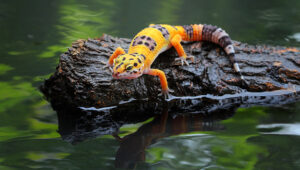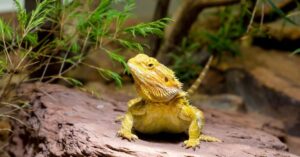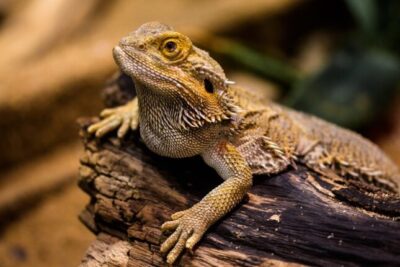In this guide, we’ll break down everything you need to know about each, from their needs and personalities to what kind of commitment they require. Whether you’re drawn to the sleek and lively gecko or the laid-back frog, let’s dive into the details to find the perfect match for you.
Understanding Geckos as Pets

1. Types of Pet Geckos
Geckos are a diverse group with many species that make excellent pets, each with its own characteristics.
- Leopard Gecko: Known for their easygoing nature and spotted patterns, leopard geckos are highly popular among beginners.
- Crested Gecko: With their cute “eyelashes” and climbing abilities, crested geckos are adored by many. They’re active and interesting to watch.
- Gargoyle Gecko and African Fat-Tailed Gecko: Other gecko species suitable for beginners, with similar care needs but unique appearances.
Each species varies in appearance, activity level, and habitat needs, so it’s important to consider which species appeals most to you.
2. Habitat and Environment Needs
Creating the right habitat is key to a gecko’s health.
- Tank size: A 10-20 gallon tank is typically sufficient for a single gecko, though some may prefer larger tanks.
- Substrate: Choose reptile carpet, paper towels, or specialized reptile substrate to avoid digestive issues.
- Lighting and Temperature: Geckos need a warm environment, ideally with temperatures between 75-90°F during the day. Heat lamps or heating pads are necessary, especially for leopard geckos who require belly heat for digestion.
- Humidity: Leopard geckos thrive in drier environments (30-40% humidity), while crested geckos need higher humidity levels (60-80%).
3. Diet and Feeding
Geckos are insectivores, meaning their diet consists primarily of insects.
- Common foods include crickets, mealworms, and occasionally, waxworms.
- Supplements: Geckos require calcium and vitamin D3 supplements to maintain bone health.
- Feed younger geckos daily, while adults may only need feeding every other day.
4. Handling and Interaction
Geckos are generally tolerant of handling, making them a good choice if you’d like to interact with your pet.
- Personality: They tend to be docile and curious, though excessive handling can stress them out.
- Guidelines: Handle geckos gently, avoiding sudden movements. For best results, limit handling to a few times per week.
5. Care Requirements
While geckos don’t require intense care, they do need routine maintenance.
- Cleaning: Weekly tank cleaning and regular removal of waste is necessary to keep the habitat sanitary.
- Veterinary Care: Regular check-ups are recommended, especially for checking for signs of metabolic bone disease, common if they don’t receive proper calcium.
- Life Span: Geckos can live 10-20 years with good care, making them a long-term commitment.
Understanding Frogs as Pets
1. Types of Pet Frogs
Frogs offer a variety of pet species, each with unique characteristics and needs.
- African Dwarf Frog: A fully aquatic species, great for beginners, with minimal care needs.
- Pacman Frog: Known for its voracious appetite and “sit and wait” hunting style.
- Tree Frogs: Green tree frogs and red-eyed tree frogs are popular, requiring arboreal (tree-based) setups.
2. Habitat and Environment Needs
Frogs have specific habitat needs based on their natural environments.
- Tank Setup: Depending on the species, you may need an aquatic, semi-aquatic, or terrestrial tank.
- Substrate: Use moss, soil, or gravel depending on the frog’s needs. Aquatic frogs will require clean water with a filter.
- Humidity and Temperature: Most frogs need higher humidity levels (60-80%) and moderate temperatures around 70-80°F. Mist the tank daily for tree frogs to maintain humidity.
- Lighting: Amphibians don’t require UV lighting like reptiles do, but natural day/night cycles are essential.
3. Diet and Feeding
Frogs are also carnivores but have a slightly different diet than geckos.
- Diet: Frogs eat live insects such as crickets, mealworms, and sometimes small fish or pinkie mice for larger species.
- Feeding Frequency: Feed young frogs daily, while adults can be fed every 2-3 days. Pacman frogs may only eat once a week due to their slower metabolism.
4. Handling and Interaction
Frogs are generally not pets that enjoy handling.
- Stress and Skin Sensitivity: Their skin is very sensitive to oils, soaps, and other substances that may be on your hands, so it’s best to handle frogs as little as possible.
- Observation Pet: Frogs are fascinating to watch, especially during feeding time, but they’re better suited as “look but don’t touch” pets.
5. Care Requirements
Frogs have different but manageable care needs.
- Tank Cleaning: Frog tanks need regular cleaning to maintain water quality and prevent bacterial growth.
- Health Concerns: Watch for signs of skin infections and other common amphibian health issues.
- Life Span: Frogs can live 5-15 years, depending on species, so they also require a level of long-term commitment.
Key Differences Between Geckos and Frogs

- Handling and Interaction
- Geckos are more interactive and generally tolerate handling better than frogs.
- Frogs are sensitive and can become stressed or harmed with excessive handling, making them ideal for observation rather than interaction.
- Care Complexity and Setup Costs
- Geckos require a dry, warm setup with some basic lighting and heat elements. Frogs may require more humidity, water filtration (if aquatic), and daily misting.
- Initial setup costs can vary but are generally similar. Maintenance for frogs can be a bit more involved due to their need for high humidity and clean water.
- Personality and Behavior
- Geckos are generally active at night, curious, and enjoy exploring their tank.
- Frogs may be more passive, with some species showing activity mainly during feeding time or at night.
Should i get a pet gecko or frog
When deciding whether to get a pet gecko or frog, it’s important to consider your lifestyle, the care needs of each species, and what you’re looking for in a companion animal. Both geckos and frogs are fascinating, low-maintenance reptiles and amphibians, but they have distinct care requirements that could make one a better fit for you than the other.
Geckos: The Low-Maintenance Reptiles
Geckos, particularly species like leopard geckos or crested geckos, are some of the most popular reptile pets. They are relatively easy to care for, have long lifespans, and are generally friendly, making them perfect for both beginners and experienced reptile enthusiasts.
Pros:
- Low-maintenance: Geckos are hardy and don’t require complex setups. They thrive in a tank with the proper temperature and humidity, and their diet mainly consists of insects like crickets and mealworms.
- Interactive: Many geckos, such as the leopard gecko, can become quite comfortable with gentle handling. Some geckos are known to form bonds with their owners, making them more interactive than other reptiles.
- Nocturnal: Geckos are primarily nocturnal, which means they’re active when you’re home from work or school. This makes them a great option if you’re not home during the day.
Cons:
- Temperature needs: They require a specific temperature range (usually between 75°F-85°F during the day, with a warmer basking area) that needs to be maintained to keep them healthy.
- Diet requirements: They need live food, which some pet owners might find inconvenient.
Frogs: The Fascinating Amphibians
Frogs, like the popular African dwarf frog or the Pacman frog, are another great pet option. Frogs are incredibly unique, with their hopping, croaking, and moist skin making them an interesting addition to any home. However, frogs typically have more specialized needs than geckos.
Pros:
- Unique appearance and behavior: Frogs are incredibly fascinating to watch, especially when they’re active. Their leaping and behavior provide endless entertainment.
- Low space requirement: Many frog species, like the African dwarf frog, don’t need a large enclosure, making them a good fit for smaller living spaces.
- Moisture-loving: Frogs enjoy a humid environment, which makes them easier to care for if you live in a naturally humid climate.
Cons:
- Sensitive to environment changes: Frogs are more sensitive to changes in their environment, such as temperature and humidity fluctuations, which can be harder to manage.
- Diet and handling: Frogs need live prey, like worms, crickets, or small fish. Frogs can also be harder to handle than geckos due to their delicate, moist skin.
- Shorter lifespan: Frogs generally have shorter lifespans than geckos, typically living between 5 and 10 years, depending on the species.
Which Is the Best Choice for You?
If you’re looking for an easy-to-care-for pet that is relatively low-maintenance and can be more interactive, a gecko is likely your best choice. Geckos generally require simpler habitat setups, can handle being handled gently, and offer more opportunities for bonding.
On the other hand, if you want a unique, fascinating pet with special behaviors to observe, and you’re willing to put in a little more effort for their care, a frog might be the right choice for you. They can thrive in more humid environments and have very distinct characteristics that many find captivating.
Making the Right Choice
Ultimately, the right choice depends on your preferences, living situation, and ability to meet the pet’s needs. Geckos are great for beginner reptile owners due to their low maintenance, while frogs offer a unique experience for those who are prepared for more specialized care.
Make sure you take the time to research both species thoroughly and ensure you can provide the right environment, food, and care before making a decision. Both geckos and frogs can make amazing pets, but choosing the one that fits your lifestyle and commitment level will ensure a rewarding experience for both you and your new companion.
Factors to Consider When Choosing
- Lifestyle and Time Commitment
- Geckos may suit people looking for a pet they can gently handle and interact with a few times a week.
- Frogs are ideal for someone with limited time for direct interaction and who would prefer a pet they can observe.
- Space and Budget
- While both need specific tank setups, geckos may require slightly more investment in heating and lighting.
- Frogs may need a larger tank if aquatic and can have ongoing costs related to water filtration and cleaning supplies.
- Long-Term Commitment
- Both geckos and frogs can be long-term pets. Consider your ability to care for a pet for up to 15-20 years in the case of geckos or 5-15 years for frogs.
Conclusion
Whether you should get a pet gecko or frog depends on your preferences, lifestyle, and ability to care for them. Geckos are often more interactive and easier to handle, while frogs tend to be lower maintenance but require a specific environment.
Both pets can make wonderful companions, but it’s important to consider their care needs before making your decision. So, should I get a pet gecko or frog? Ultimately, it comes down to which pet fits your personality and the time you can dedicate to their care.

